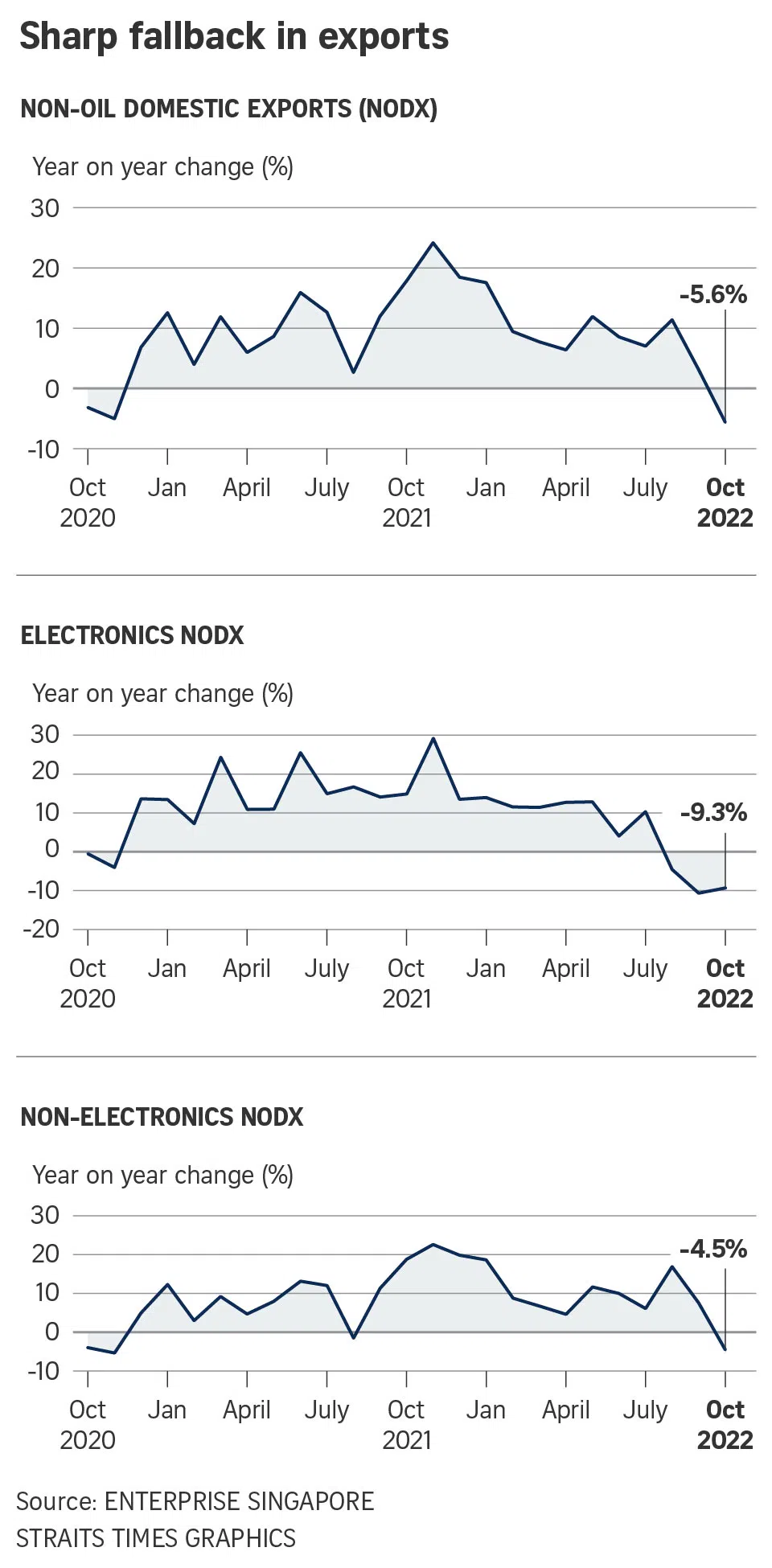Singapore non-oil exports shrink for first time in nearly 2 years with 5.6% drop in October
Sign up now: Get ST's newsletters delivered to your inbox

The drop was worse than the 1.7 per cent contraction forecast by analysts in a Bloomberg poll.
PHOTO: ST FILE
Follow topic:
SINGAPORE - Singapore’s key exports snapped 22 months of growth in October, and economists said they expect the downtrend to continue as external demand weakens, with recessions likely in the United States and euro zone early next year.
Non-oil domestic exports (Nodx) shrank 5.6 per cent year on year last month, reversing September’s 3.1 per cent growth, data from Enterprise Singapore (EnterpriseSG) showed on Thursday.
The drop was worse than the 1.7 per cent contraction forecast by analysts in a Bloomberg poll.
On a seasonally adjusted basis, October’s Nodx came in at $15.9 billion. This was a decline from the high base a year ago, EnterpriseSG noted, with Nodx in October 2021 at $16.6 billion, above 2021’s monthly average of $16.1 billion.
The weak Nodx numbers were led by the fall in electronics exports, which shrank by 9.3 per cent year on year in October, after a 10.6 per cent drop in the previous month.
Singapore’s electronics exports, which account for around a quarter of domestic exports, have now declined for three straight months.
October’s drop was led by a 45.7 per cent plunge in shipments of disk media products, with personal computer parts falling 31.6 per cent and semiconductors or integrated circuits down 11.1 per cent.
Non-electronic exports fell 4.5 per cent, reversing from September’s 7.6 per cent expansion.
Pharmaceuticals (-34.7 per cent), non-monetary gold (-45.5 per cent) and petrochemicals (-18.4 per cent) contributed the most to the decline in non-electronic shipments.
On a month-on-month seasonally adjusted basis, Nodx fell for the third straight month, shrinking 3.7 per cent to $15.9 billion and missing analysts’ forecasts for a 2.1 per cent drop.
Singapore’s Nodx growth is likely to fall again in November and December, bringing full-year 2022 growth to the lower end of the official growth forecast of 5 per cent to 6 per cent, said Ms Selena Ling, chief economist for OCBC Bank.
With rising interest rates and persistently high inflation, coupled with ongoing geopolitical uncertainties, the likely development of growth and trade may remain patchy for the rest of 2022 and into the first quarter of 2023, she added.
“With global central banks having aggressively front-loaded their monetary policy tightening for most of 2022 in an attempt to tamp down demand conditions, it appears that global growth prospects are set for a more dramatic slowdown into 2023 as many central banks prioritise combating inflation over supporting growth.”
Mr Alex Holmes, senior Asia economist at Oxford Economics, said any revival in China’s growth might not be enough to offset weaker global demand.
“Exports are also likely to suffer from a turn in the semiconductor cycle, following the weakening trend of electronics-heavy North Asian exporters,” he said.
Nodx to Singapore’s top 10 markets declined as a whole in October, and only four of them showed expansions, down from eight in September.
This reflects the broadening demand weakness among Singapore’s key export markets, said UOB senior economist Alvin Liew.
The China market was the worst hit, with shipments sliding 32 per cent in October, after shrinking 33.7 per cent in September.
It was followed by the European Union, with a 19.5 per cent drop, reversing a 3 per cent rise in September.

However, Nodx to the US, Taiwan, Japan and South Korea rose, all faster than growth in the previous month. Exports to Taiwan performed the best, expanding 21.6 per cent after a 10 per cent rise in September.
A China reopening remains a wild card in 2023, which could potentially boost Singapore’s exports as China alone accounts for 17.6 per cent of total Nodx, said Maybank economists Chua Hak Bin and Lee Ju Ye. They cautioned that the drop in exports may be an early warning sign of a potential Singapore recession in 2023, led by a downturn in manufacturing and trade-related services.
But some of Singapore’s reopened sectors, like hospitality, aviation, food and beverage, and construction, will still expand at a healthy pace, they added.
Total trade grew 8.6 per cent in October from a year ago, though this was mainly due to the increase in the oil trade, which expanded by 23 per cent on the back of higher prices, said EnterpriseSG. Exports rose 6.3 per cent while imports were up 11.1 per cent.

